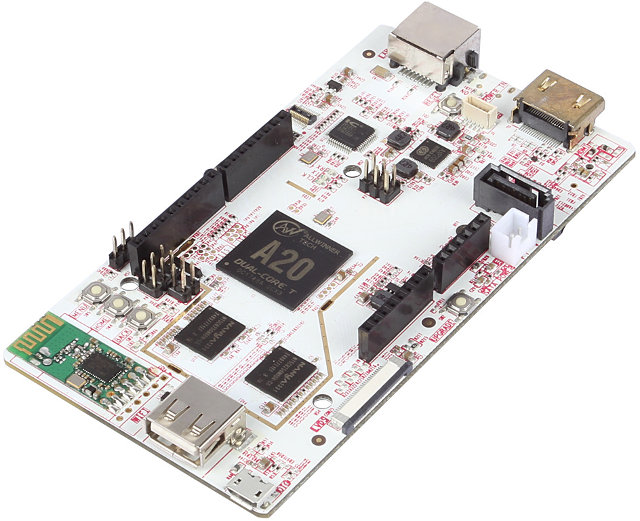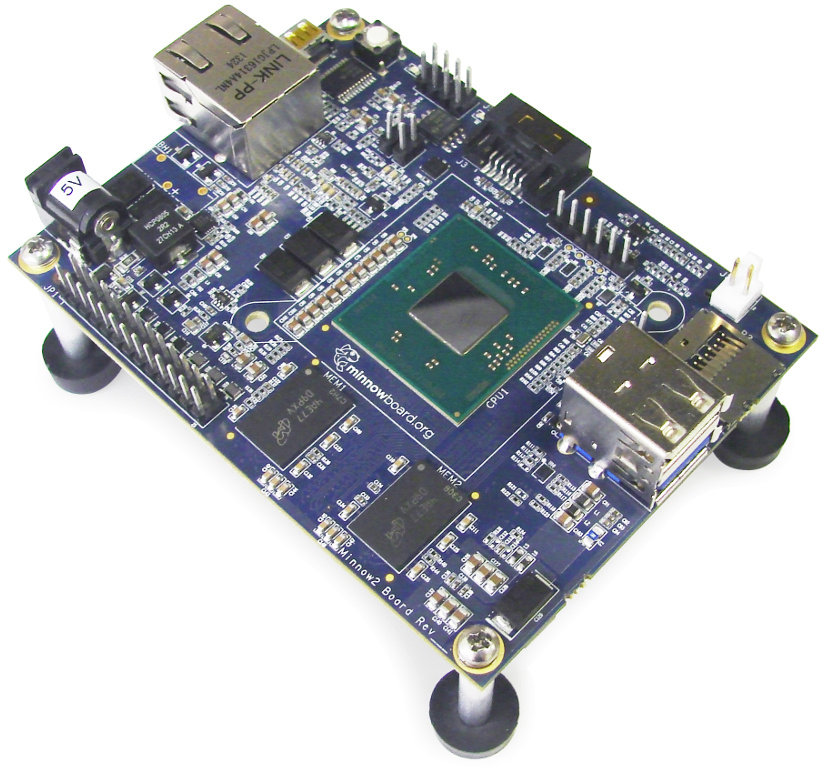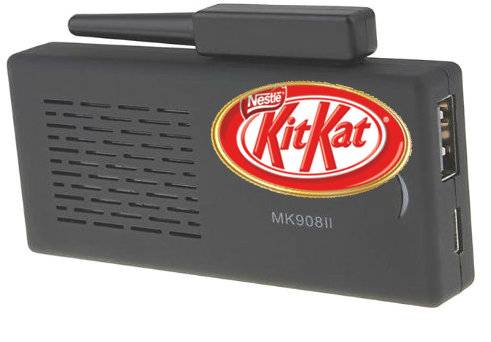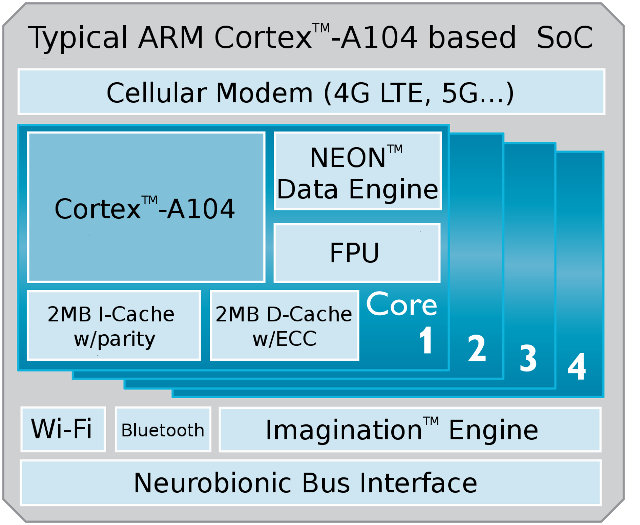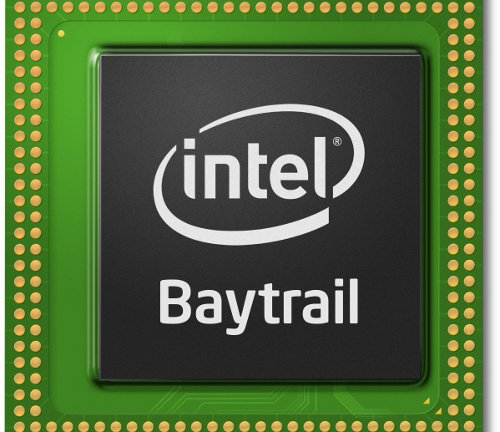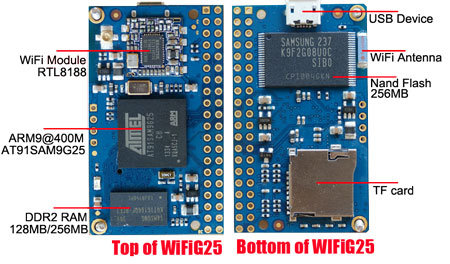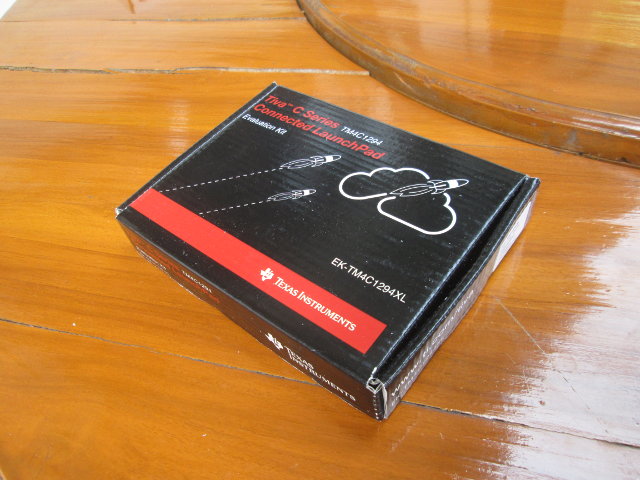The first pcDuino board powered by AllWinner A10 has been available for about a year, later last year pcDuino V2 was released with a built-in Wi-Fi modules and mechanically and software compatible Arduino headers, and now pcDuino3 has been announced in a form factor similar to pcDuino V2 board but replacing AllWinner A10 Cortex A8 SoC with AllWinner A20 dual core Cortex A7, and improving overall specs such as faster Ethernet, the addition of a SATA port, and LiPo support. pcDuino3 specifications: SoC – AllWinner A20 dual core ARM Cortex A7 @ 1.0 GHz, with Mali 400MP2 GPU System Memory – 1GB DRAM Storage – 4GB NAND Flash, SATA connector, and microSD card slot (up to 32GB) Video Output – HDMI 1.4 with HDCP support, LVDS header Audio Out – 3.5mm analog audio interface, I2S stereo digital audio interface Connectivity – WiFi, 10/100M Ethernet USB – 1x USB host, 1x […]
$99 MinnowBoard MAX Development Board Powered by Intel Bay Trail-I SoC
When Intel released the original MinnowBoard which was a step in the right direction, but there were some complains, as the company had chosen to use an older Intel processor, and the price was much higher than most high performance low cost ARM development boards. MinnowBoard MAX (aka Minnow2 Board) fixes all that, as it features the latest Intel Bay Trail-I (E3800 series) processor, and costs as low as $99 for the single core version, and $129 for the dual core version. Let’s jump directly to the specifications: SoC – 64-bit Intel Atom E3815 (single-core, 1.46 GHz) or Atom E3825 (dual-core, 1.33 GHz) both with integrated Intel HD Graphics coming with Open Source hardware-accelerated drivers for Linux OS System Memory – 1GB ($99 model) or 2GB ($129 model) DDR3 RAM Storage – 1x Micro SD card slot, 1x SATA2 3Gb/sec, 8 MB SPI Flash for firmware (UEFI) Video Output – micro […]
Linux Kernel 3.14 Release
Linus Torvalds announced the release of Linux Kernel 3.14 yesterday: So we had a few fairly late changes that I could have done without, but the changelog from -rc8 is still pretty small, and I’m feeling pretty good about it all. If we did end up with any last-minute problems due to the final spurt of patches, they’ll be pretty specific, and it really didn’t make sense to me to delay the release without anything known pending. Much of the final spurt were either marked for stable or known regressions. So 3.14 is out there, and the merge window for 3.15 is thus open. Please do spend the time to test out 3.14, though, even if you might otherwise be in a hurry to send me your pending queue for the next release. Linus Kernel 3.13 brought a scalable block layer for high-performance SSDs, nftables, NFC payment support, squashfs performance […]
Official Android 4.4 Firmware for RK3188T HDMI TV Sticks Released
At the very end of last year, a beta Android 4.4.2 firmware for Rockchip RK3188 mini PCs was released, and yesterday, GeekBuying announced an official Android 4.4.2 firmware for Rockchip RK3188T (notice the T) mini PCs with AP6210 Wi-Fi modules,with bug fixes from the beta version. This should work with device such as MK908II and MK809III. There are at least two caveats however. First, I understand it will only work on RK3188T, not RK3188, and hopefully an official RK3188 mini PC firmware will be released soon, but since manufacturers may have changed from RK3188 to RK3188T for the same model during manufacturing, you have to make sure which version you are using. You can do so by installing CheckRK3188 app on your device, and check if you have the slower RK3188T SoC, or the older, but faster RK3188. The second issue is that Google Apps (Play store, gmail) are not pre-installed. You […]
Revolutionary ARM Cortex A104 Leverages the Human Brain and Assets, To Make Smartphones and Tablets Obsolete by 2020
The mobile devices we use everyday, such a smartphones and tablets, are all designed around one application processor that’s connected to memories, sensors, a display, some communication modules, and so on. But thanks to the work by ARM, and their Cortex A104, the way we do mobile computing maybe be dramatically transformed in a few years, and mobile devices may completely disappear from the market place. Who is this smartphone killer? Meet ARM Cortex A104 which can connect to the human brain via neurobionic interfaces, and leverage “assets” such as the eyes, ears, and vocal cords. A display won’t be needed as graphics will be rendered directly in the brain via ARM ImaginationTM Engine, which also handles traditional 2D/3D graphics processing. There will most likely be at least two display modes. If you close your eyes, the system will switch to immersive mode, where everything you see is rendered by […]
Intel To Launch Quad Core Z37x5 Atom Bay Trail-T SoCs
CPU World reports Intel is preparing to launch at least 9 new Bay Trail-T processors for Android and Windows 8.1 tablets. The new processors will be part of Atom Z37x5 product line, which offers up to 16% better graphics performance. All SoCs are built on Silvermont (22nm) microarchitecture, come with 4 CPU cores, 2 MB L2 cache, and Ivy Bridge-based GPUs. The most powerful will be Z3795 with four CPU cores clocked at 1.6 GHz, with burst speeds reaching up to 2.39 GHz, a GPU clocked between 311 and 778 MHz, and support for up to 4GB RAM. Z3735E is the processor with the weakest specs, and must be the cheapest of the lots. It’s clocked at 1.33 GHz (Turbo: 1.83 GHz) and support a mere 1GB RAM max. CPU World has specs for seven models as shown in the table below. Model Cores Frequency /Turbo L2 cache Max RAM […]
$30 CoreWind Tech WiFiG25 SoM Features Atmel SAM9G25 ARM9 Processor and a Wi-Fi Module
After their Aria G25 clone, called CORE9G25, CoreWind Tech has now launched a new SoM, WiFiG25, also powered by Atmel SAM9G25 ARM9 processor, but this time with a WiFi Module based on Realtek RTL8188, and up to 256 MB RAM, 256 MB Flash. Here are the specs of this system-on-module: CPU – Atmel AT91SAM9G25 ARM9 @ 400Mhz System Memory – 128 or 256 MB DDR2 Storage – 256MB NAND Flash, micro SD card slot Connectivity – WiFi Module with internal antenna 2x20Pin 2.54mm expand interface (through holes) with access to 2x USB host ports, 3x UART, 1x I2C, 1x SPI, 6x PWM, 27x GPIOs, and 4x 10-bit ADC Line level – TTL 3.3V Misc – User LED Power supply – 5V Dimensions – Size: 50.80 x 30 mm Weight – 5g Temperature range – Commercial: 0 to 70 °C, or industrial: -20 to 85 °C The company provide Linux 3.6.9 for the […]
Texas Instruments Tiva C Series Connected LaunchPad Unboxing and Quick Start Guide
Texas Instruments Tiva C Series TM4C1294 Connected LaunchPad is an evaluation kit for the Internet of things with a Cortex-M4 MCU (Tiva TM4C1294), an Ethernet port, and USB interfaces for power and debugging. At $19.99 including shipping via Fedex, it’s one of the cheapest ways to get devices online. I’ve purchased one via TI e-Store, and already received it. I’ll post some pictures of the kit, go through the Quick Start Guide, and provides links to resources to go further. EK-TM4C1294XL Connected LaunchPad Unboxing I’ve received the kit in the package below with feature a QR Code linking to http://www.ti.com/launchpad, as well basic specifications (refer to my previous post for specs), list of tools (Code composer studio, Tivaware, Keil, IAR…) and package content. In the box we’ve got the board itself, a retractable Ethernet cable, a USB to micro USB cable for power and debugging, and Connect LaunchPad Quick Start […]


